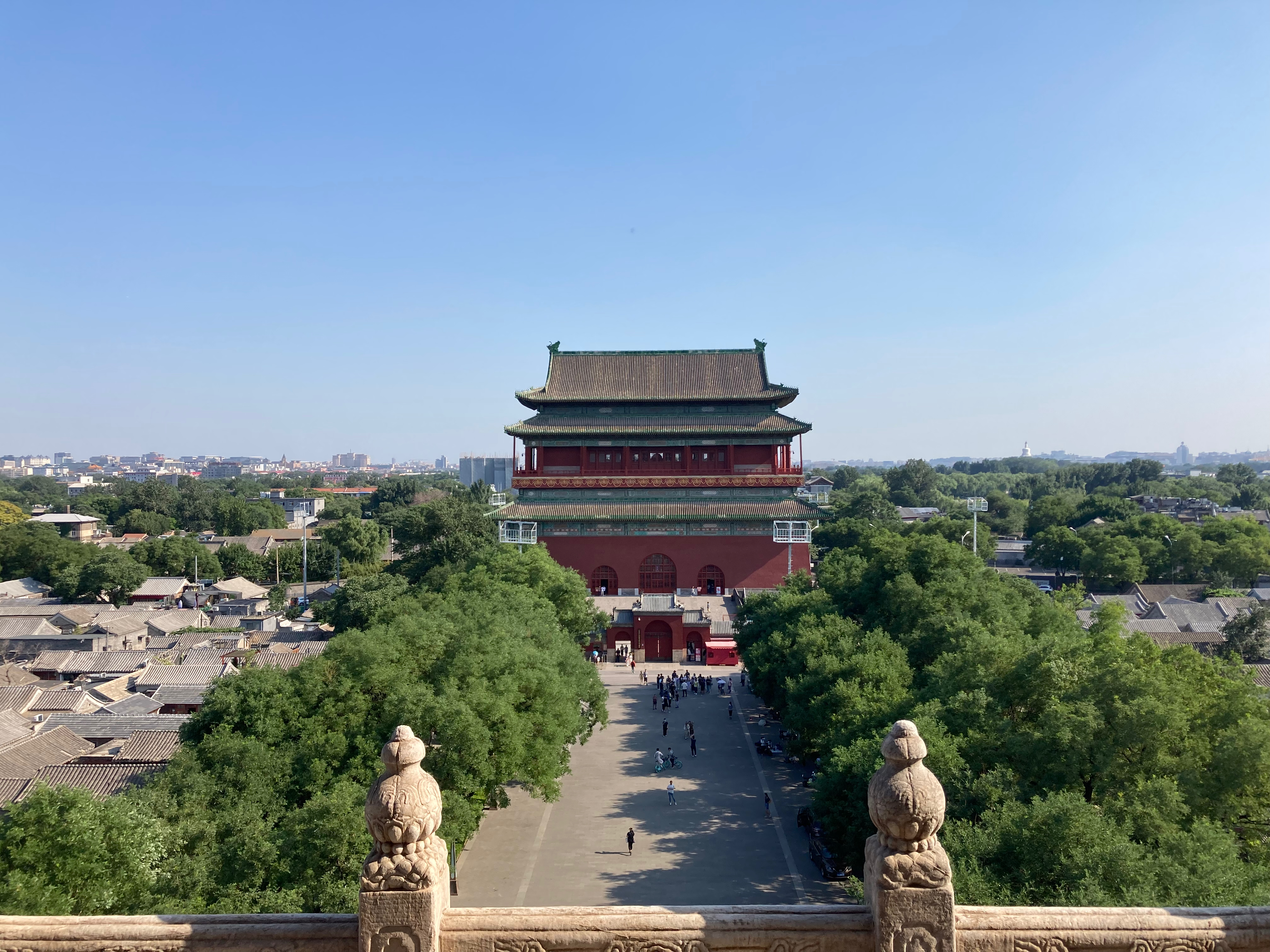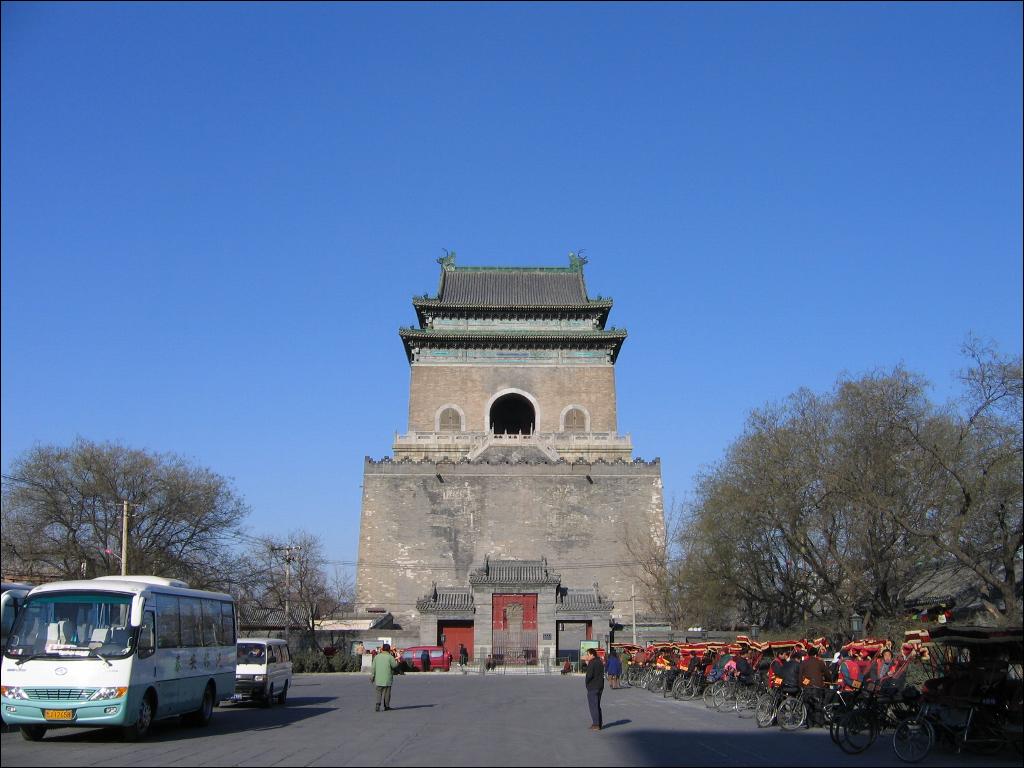Gulou and Zhonglou (Beijing) on:
[Wikipedia]
[Google]
[Amazon]

 The Drum Tower of
The Drum Tower of

Chinaguide.com: The Beijing Drum Tower
— ''360-degree virtual tour and photographs''. * — ''30 high quality photographs''. {{coord, 39, 56, 24.68, N, 116, 23, 22.69, E, display=title, region:CN_type:landmark Buildings and structures in Beijing Towers in China Dongcheng District, Beijing Major National Historical and Cultural Sites in Beijing Museums in Beijing Tourist attractions in Beijing Yuan dynasty architecture Ming dynasty architecture Articles containing video clips

 The Drum Tower of
The Drum Tower of Beijing
Beijing, Chinese postal romanization, previously romanized as Peking, is the capital city of China. With more than 22 million residents, it is the world's List of national capitals by population, most populous national capital city as well as ...
, or Gulou (), is situated at the northern end of the central axis of the Inner City to the north of Di'anmen Street. Originally built for musical reasons, it was later used to announce the time and is now a tourist attraction.
The Bell Tower
A bell tower is a tower that contains one or more bells, or that is designed to hold bells even if it has none. Such a tower commonly serves as part of a Christian church, and will contain church bells, but there are also many secular bell to ...
of Beijing, or Zhonglou (), stands closely behind the drum tower. Together, the Bell Tower and Drum Tower have panoramic views over central Beijing. Before the modern era, both towers dominated the Beijing skyline.
Function
Bothbell
A bell /ˈbɛl/ () is a directly struck idiophone percussion instrument. Most bells have the shape of a hollow cup that when struck vibrates in a single strong strike tone, with its sides forming an efficient resonator. The strike may be m ...
s and drum
The drum is a member of the percussion group of musical instruments. In the Hornbostel–Sachs classification system, it is a membranophone. Drums consist of at least one membrane, called a drumhead or drum skin, that is stretched over a ...
s were used as musical instrument
A musical instrument is a device created or adapted to make Music, musical sounds. In principle, any object that produces sound can be considered a musical instrument—it is through purpose that the object becomes a musical instrument. A person ...
s in ancient China
China, officially the People's Republic of China (PRC), is a country in East Asia. With population of China, a population exceeding 1.4 billion, it is the list of countries by population (United Nations), second-most populous country after ...
. Later, they were used by government and communities to announce the time. The Bell and Drum Towers were central to official timekeeping in China during the Yuan, Ming, and Qing
The Qing dynasty ( ), officially the Great Qing, was a Manchu-led Dynasties of China, imperial dynasty of China and an early modern empire in East Asia. The last imperial dynasty in Chinese history, the Qing dynasty was preceded by the ...
dynasties.
The Bell and Drum Towers continued to function as the official timepiece of Beijing until 1924. That year, the Beijing Coup led to the expulsion of Puyi
Puyi (7 February 190617 October 1967) was the final emperor of China, reigning as the eleventh monarch of the Qing dynasty from 1908 to 1912. When the Guangxu Emperor died without an heir, Empress Dowager Cixi picked his nephew Puyi, aged tw ...
, the last emperor of the Qing Dynasty, from the Forbidden City
The Forbidden City () is the Chinese Empire, imperial Chinese palace, palace complex in the center of the Imperial City, Beijing, Imperial City in Beijing, China. It was the residence of 24 Ming dynasty, Ming and Qing dynasty, Qing dynasty L ...
, and the adoption of Western
Western may refer to:
Places
*Western, Nebraska, a village in the US
*Western, New York, a town in the US
*Western Creek, Tasmania, a locality in Australia
*Western Junction, Tasmania, a locality in Australia
*Western world, countries that id ...
-style clock
A clock or chronometer is a device that measures and displays time. The clock is one of the oldest Invention, human inventions, meeting the need to measure intervals of time shorter than the natural units such as the day, the lunar month, a ...
s for official time-keeping.

History
The Drum Tower was built in 1272 during theYuan dynasty
The Yuan dynasty ( ; zh, c=元朝, p=Yuáncháo), officially the Great Yuan (; Mongolian language, Mongolian: , , literally 'Great Yuan State'), was a Mongol-led imperial dynasty of China and a successor state to the Mongol Empire after Div ...
. At that time the city was called Khanbaliq
Khanbaliq (; , ''Qaɣan balɣasu'') or Dadu of Yuan (; , ''Dayidu'') was the Historical capitals of China, winter capital of the Mongol-led Yuan dynasty in what is now Beijing, the capital of China today. It was located at the center of modern ...
and the tower was named the Tower of Orderly Administration (). The name symbolizes what were known as the comprising elements of the universe in ancient China, including metal, wood, water, fire, earth, the sun and the moon. In 1420, during the reign of the Yongle Emperor
The Yongle Emperor (2 May 1360 – 12 August 1424), also known by his temple name as the Emperor Chengzu of Ming, personal name Zhu Di, was the third List of emperors of the Ming dynasty, emperor of the Ming dynasty, reigning from 1402 to 142 ...
, the building was rebuilt to the east of its original site. The Qing dynasty
The Qing dynasty ( ), officially the Great Qing, was a Manchu-led Dynasties of China, imperial dynasty of China and an early modern empire in East Asia. The last imperial dynasty in Chinese history, the Qing dynasty was preceded by the ...
carried out important renovations in 1800. Following the Beijing Coup in 1924, Feng Yuxiang
Feng Yuxiang (; ; 6 November 1882 – 1 September 1948), courtesy name Huanzhang (焕章), was a Chinese warlord and later general in the National Revolutionary Army. He served as Vice Premier of the Republic of China from 1928 to 1930.
A ...
removed the official status of the towers, replacing them with Western time-keeping methods, and renamed the building as the Tower of Clarifying Shame (). Objects related to the Eight-Nation Alliance's invasion of Beijing and later the May 30 Massacre of 1925 were put on display, turning the towers into a museum. The upper story of the Drum Tower currently serves as the People's Cultural Hall of the Dongcheng District.
In the 1980s, after much repair work, the Bell and Drum Towers were opened to tourists.
During the 2008 Summer Olympics
The 2008 Summer Olympics (), officially the Games of the XXIX Olympiad () and officially branded as Beijing 2008 (), were an international multisport event held from 8 to 24 August 2008, in Beijing, China. A total of 10,942 athletes fro ...
, held in Beijing, three people were stabbed at the Drum Tower, resulting in one death.
Architecture
The Drum Tower is a -tall two-story building made of wood. The upper story of the building housed one main drum and 24 smaller drums, of which only the main drum remains. New drums have been made to replace them. Nearby stands the Bell Tower, a -tall edifice with gray walls and a green glazed roof.See also
*Imperial City, Beijing
The Imperial City () is a section of the city of Beijing in the Ming dynasty, Ming and Qing dynasty, Qing dynasties, with the Forbidden City at its center. It refers to the collection of gardens, shrines, and other service areas between the Forb ...
References
External links
Chinaguide.com: The Beijing Drum Tower
— ''360-degree virtual tour and photographs''. * — ''30 high quality photographs''. {{coord, 39, 56, 24.68, N, 116, 23, 22.69, E, display=title, region:CN_type:landmark Buildings and structures in Beijing Towers in China Dongcheng District, Beijing Major National Historical and Cultural Sites in Beijing Museums in Beijing Tourist attractions in Beijing Yuan dynasty architecture Ming dynasty architecture Articles containing video clips
China
China, officially the People's Republic of China (PRC), is a country in East Asia. With population of China, a population exceeding 1.4 billion, it is the list of countries by population (United Nations), second-most populous country after ...
Drum towers